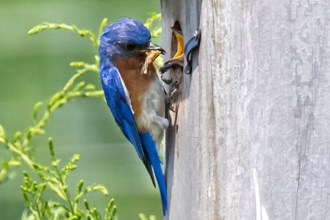Protecting Birds
Threats to Birds and How We Can Help
Birds are well adapted to living in the habitats in which they have evolved. However, human-caused alterations to these habitats, intentional or not, have posed serious threats to many species of birds. The most serious threat is loss of habitat, and one must understand that for some species of birds this habitat can be very specific. To sustain or improve bird habitat, we suggest landscaping with native plants. The paragraphs that follow deal with two threats to birds that are mostly unintentional, but very lethal.



Window Collisions
The first threat to birds is window collisions. The problem is that from the outside looking at a window is similar to looking at a mirror. When looking at a window, a bird sees tree branches, shrubs, and sky, but does not realize they are reflections. BANG! Often this happens as birds are suddenly put into a state of evasive action when a predator appears.
What can you do? Stand outside your windows and look at them from a bird’s point of view. If the reflection looks like a safe and inviting spot, you need to take action. Several products which you can affix or apply to your windows are available commercially. We will not endorse any of them but you can enter “window collisions birds” in your computer’s search engine and see what comes up. Your own ingenuity can also lead to improving the situation; hanging streamers, strips of masking tape, pieces of paper, or dirty windows! Understand that a fair amount of the window needs to be “treated” in order to be effective. Placement of bird feeders can make a difference. Too close to a window (3-25 feet) and a bird fleeing from the feeder as a Cooper’s Hawk appears will be at maximum speed as it strikes the window. Try placing your feeders, or doing plantings, so that branches or shrubs are between your feeders and windows. One other thing you can do is put pressure on local business and government establishments which have large window exposures to do something. This has been successful in several cities.
Cats
The second threat to birds is free roaming cats. This can be a touchy subject and one must be diplomatic when discussing it with a cat affectiono. Cats kill birds, and lots of them; hundreds of millions each year according to scientists’ estimates. The domestic cat is a “new kid on the block” and North American birds have not evolved defensive adaptations to deal with it.
How can we deal with this issue? Putting bells on outdoor cats is minimally effective at best. Cats are skilled predators and are able to stalk their prey silently, and then pounce. By the time the bird hears the bell, it is too late. Keeping cats indoors is by far the most effective way to deal with this problem. If a cat owner mentions that happy cats are free-roaming cats, you could explain that several dangers can befall outdoor cats, such as foxes, coyotes, dogs, other cats, vehicles, traps, poisons, disease and dangerous weather extremes. Happy, free-roaming cats can often become unhappy, or dead, cats. Many cities also have ordinances that do not allow free-roaming cats. Be aware of your local laws to avoid violation and fines. Remember, be diplomatic. Finally, pertaining to this subject, the maxim needs to be spread that releasing an unwanted cat into the wild, assuaging the act by thinking that it can fend for itself, is very bad for both the cat and the wild.
Other Resources and Websites
The American Bird Conservancy provides many helpful educational resources to learn about and prevent bird window strikes.
The American Bird Conservancy’s Cat Indoors campaign is one of the most comprehensive sources of online information about the impacts that cats have on wildlife populations and diseases in both cats and humans. The organization advocates responsible pet ownership solutions, such as outdoor enclosures (e.g., “catios”), harnesses, backpacks, strollers, indoor enrichment ideas, and anti-predation devices to use as you transition your outdoor cat to be an indoor cat. The organization also opposes Trap, Neuter, Release (TNR) program for feral cats. The TNR program has not been shown to reduce feral cat populations and it also continues to maintain feral cats on the landscape, thus still contributing to wildlife and public health risks.
The American Veterinary Medical Association encourages the public to be educated about the risks associated with allowing cats to free-roam outdoors.
The Cornell Lab of Ornithology provides 10 ways to help birds. We encourage you to check these out and share them with others.
